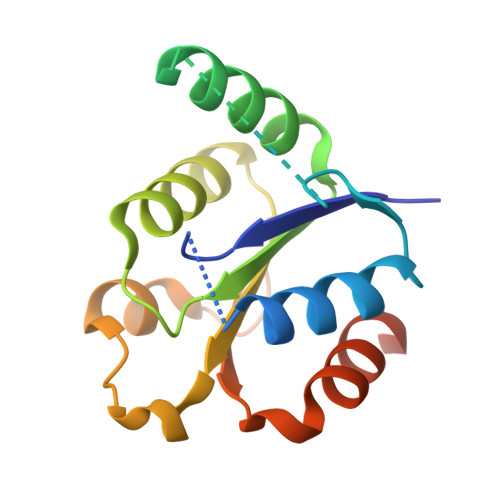Use of Direct-to-Biology Strategies for the Discovery of 2'-Deoxynucleoside 5'-Monophosphate N-Glycosidase (DNPH1) PROTACs.
Anderson, N.A., Barlaam, B., Argyrou, A., Astles, P.C., Bruss, H., Cadogan, E.B., Carlino, L., Alonso-Crisostomo, L., Collie, G.W., Edwards, A.J., Gryniukova, A., Hall, J., Jamal, K., Kent, J., Kitching, L., Kourra, C., Lam, C., Milbradt, A.G., Nikkila, J., Northall, S., O'Connor, M.J., Overman, J., Pathe, C., Savory, W., Slade, D., Spencer, J.A., Stead, D., Stubbs, C.J., Whitehurst, B.C., Winfield, S.(2025) J Med Chem
- PubMed: 41183227
- DOI: https://doi.org/10.1021/acs.jmedchem.5c02337
- Primary Citation of Related Structures:
9I9Q, 9IA6, 9RG8 - PubMed Abstract:
2'-Deoxynucleoside 5'-monophosphate N-glycosidase (DNPH1) has emerged as an attractive target for cancer therapeutics exploiting DNA damage response pathways, yet chemical degraders for interrogating DNPH1 biology are lacking. We report the accelerated discovery of potent DNPH1 PROTACs using a direct-to-biology synthesis and screening platform. We employed miniaturized, array-based chemistry to generate a broad library of quinazoline-based PROTACs capable of recruiting a variety of different E3 ligases. Screening crude reaction mixtures in a cellular degradation assay enabled rapid identification of multiple nanomolar DNPH1 PROTACs, exemplified by compound 59 , which achieved near-complete DNPH1 degradation and demonstrated strong functional activity in BRCA1 mutant cell lines. Mechanistic studies confirmed selective, proteasome- and VHL-dependent protein knockdown and recapitulation of phenotypic outcomes observed with DNPH1 genetic loss, including sensitization to hmdU treatment. Our findings highlight the power of D2B methodology to streamline PROTAC development and establish quinazoline-based degraders as robust chemical tools to advance DNPH1-targeted cancer research.
- Oncology R&D, AstraZeneca, Cambridge CB2 0AA, United Kingdom.
Organizational Affiliation:

















